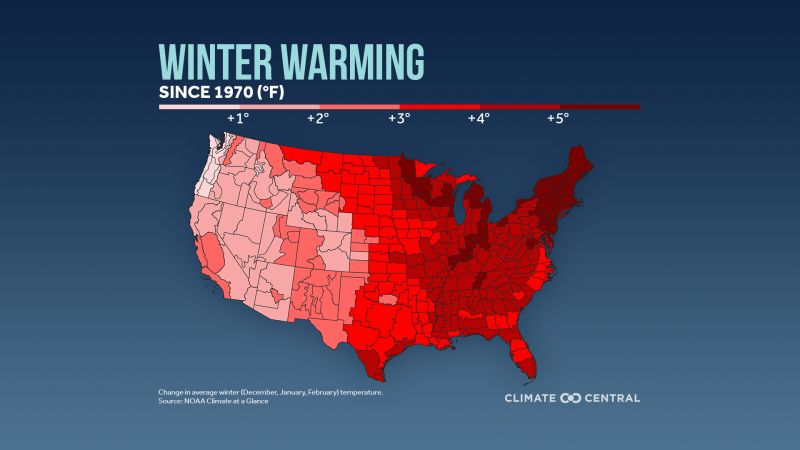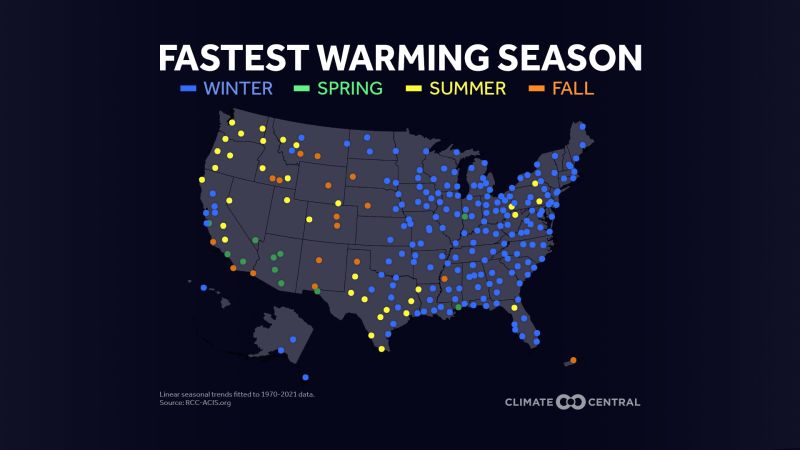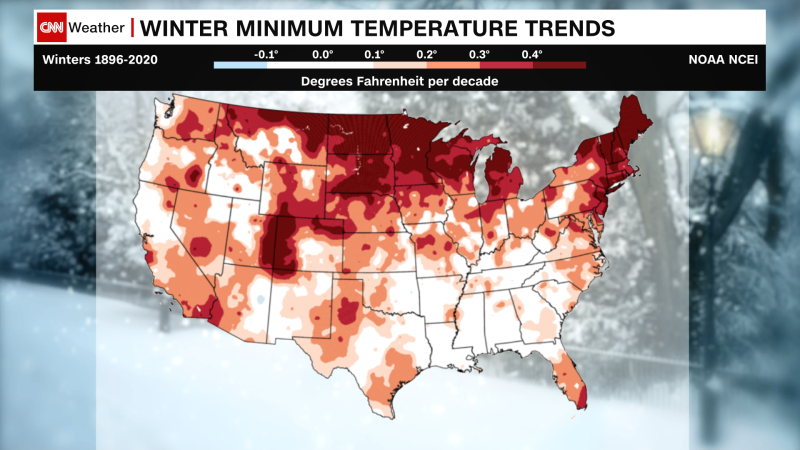
Chilly Reception: Winter is Losing its Frosty Charm

Winter's changing face: Human-caused climate change accelerates warming, reshaping snow, tourism, winter sports, meals, and allergies, altering the season's allure
The arrival of winter is upon us, yet for many parts of the United States, it doesn't quite feel like it. At 10:27 p.m. ET on Thursday, the Earth's Northern Hemisphere will be at its farthest distance from the sun, signifying the winter solstice: the shortest day of the year and the official beginning of the coldest season.
Winter is experiencing rapid warming due to human-caused climate change, and this is affecting various aspects such as snow, tourism, winter sports, local economies, meals, and allergies. An analysis of NOAA temperature data by Climate Central, a nonprofit climate research group, found that the winter period from December to February is now the fastest-warming season for almost 75% of the US.
The study examined the average winter temperatures in 240 locations across the United States and discovered that the winter warming trend is evident in every area of the country. Temperatures had increased in 97% (233) of the locations since 1970.
Climate Central
Winter temperatures increased by 3.8 degrees Fahrenheit on average since 1970 in these warming locations. Winters in the fastest-warming cities have warmed by as much as 7 degrees.
The Northeast and Upper Midwest are experiencing the fastest increase in temperatures, with an average winter warming of nearly 5 degrees. Ski towns like Burlington, Vermont (with a 7.7 degree increase) and Concord, New Hampshire (with a 6.6 degree increase) are notably impacted. Even notoriously cold Milwaukee now has an average winter temperature that is 6.7 degrees warmer.
While some may find the idea of a slightly warmer winter appealing, the reality is that milder winters come with consequences.
"Winter is significant for the life cycles of plants, animals, and insects, as well as for replenishing freshwater supplies and sustaining snow and ice for winter recreation, which is crucial for local economies," explained Lauren Casey, a meteorologist at Climate Central.
A warmer winter doesn't equate to sweltering summer-like conditions all season long. There will still be cold days in a warmer climate, but they will become less frequent and extreme as average temperatures rise, allowing less room for extreme cold swings.
Climate Central
The duration of cold snaps in the US has decreased by an average of six days since 1970, according to Climate Central. While cold temperatures may still break records occasionally, warm records are much more common.
In 2023, there were twice as many warm temperature records as cold ones. According to NOAA data, this trend is even more pronounced at night, with three times as many record warm low temperatures compared to record cold ones.
Overnight minimum temperatures during winter have been warming at a faster rate than any other season since records began in 1896. According to a CNN analysis of NOAA data, winter overnight temperatures have been warming at a rate of 1.78 degrees per century since 1900 - 25% faster than the rate for winter daytime highs.
Additionally, a separate analysis by Climate Central found that 88% of 231 US locations experienced a long-term decrease in the average number of freezing nights each year since 1970, with 204 cities showing this trend.
CNN
Reno, Nevada has experienced a significant decrease, with an average of 91 fewer freezing nights each year, making it the location that has lost the most on the list. Similarly, cities in Nevada, Arizona, California, and Florida, which used to have the occasional freezing night, no longer experience the cold at all. Even cities like Buffalo, New York, Chicago, New York City, Boston, and Detroit, known for cold outbreaks, now have fewer freezing nights, with two to three weeks less each year.
The changes will have a detrimental impact on industries that depend on consistent cool weather. According to a study, the allergy season is projected to begin earlier than usual and be more severe due to the climate crisis.
A report by the International Olympic Committee revealed that increasing temperatures could potentially delay the start of ski season by up to a month and shorten it by up to three months. This discovery poses a potential threat to the US economy, with a projected loss of $1 billion according to a 2018 study conducted by the climate advocacy groups POW and REI.
Additionally, the warming winters are impacting the US fruit and nut industry, worth $27 billion, by reducing the necessary chilling time for crops to properly bloom in the spring. This was confirmed by an analysis from Climate Central.
In California's fertile Central Valley, where 40% of the US fruits and nuts are grown, the US Department of Agriculture predicts a potential 25% drop in viable chill time by the end of the 21st century. This decrease could result in a reduced production of walnuts, pistachios, and cherries, with the remaining produce being of lower quality, according to the USDA.
Casey informed CNN that this could potentially have a significant impact on food companies and lead to higher food prices, contributing to or exacerbating food insecurity. Additionally, the extended and warmer growing season can also lead to increased exposure to pests and pollen, which can worsen allergies.
Worse yet, for winter lovers: The season of sniffles and sneezes will also be here sooner than you might expect  warming winters are causing spring to start weeks ahead of schedule.
















